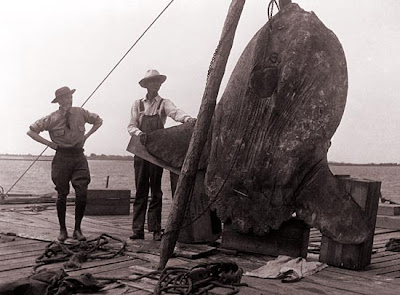In May 1926 the grounded fish was spotted in Bogue Inlet by mariner William Edward Mattocks. Captain Mattocks succeeded in towing the huge fish to Swansboro. After notifying the North Carolina State Museum, curator H.H. Brimley and assistant Harry Davis hurried to Swansboro where they took measurements and made field notes. A paper mâché replica was created; it is on exhibit at the North Carolina State Museum of Natural Sciences in Raleigh.
The ocean sunfish, Mola Mola, or common mola, is the heaviest known bony fish in the world. It has an average adult weight of one ton. The species is native to tropical and temperate waters around the globe. It resembles a fish head with a tail, and its main body is flattened laterally. Sunfish can be as tall as they are long when their dorsal and ventral fins are extended.
Sunfish live on a diet that consists mainly of jellyfish. Because this diet is nutritionally poor, they consume large amounts in order to develop and maintain their great bulk. Females of the species can produce more eggs than any other known vertebrate. Sunfish fry resemble miniature pufferfish, with large pectoral fins, a tail fin and body spines uncharacteristic of adult sunfish.
*This 1926 photo is courtesy of the North Carolina State Museum of Natural Sciences in Raleigh, where the Mola Mola is on exhibit. The photo was taken by J.F. Cunningham. The man on the left is Harry T. Davis, Assistant Curator at the museum and the man on the right is Reiny Foster who may be an employee of the New Riverview Hotel or the Swansboro Ice Company. In using this image, the Museum of Natural Sciences prefers asking permission first and then giving proper credit.
